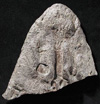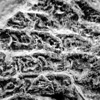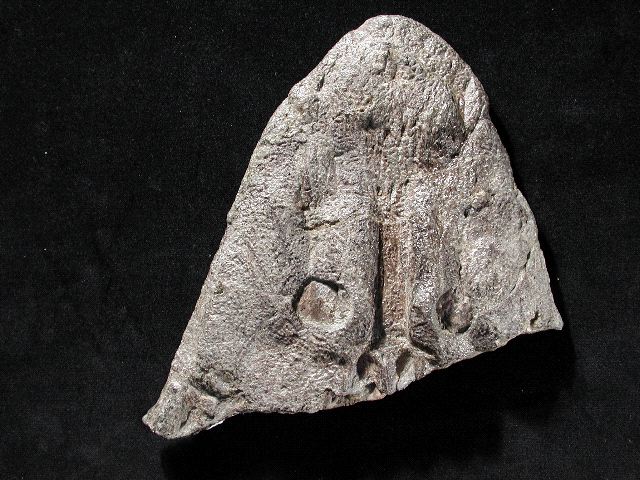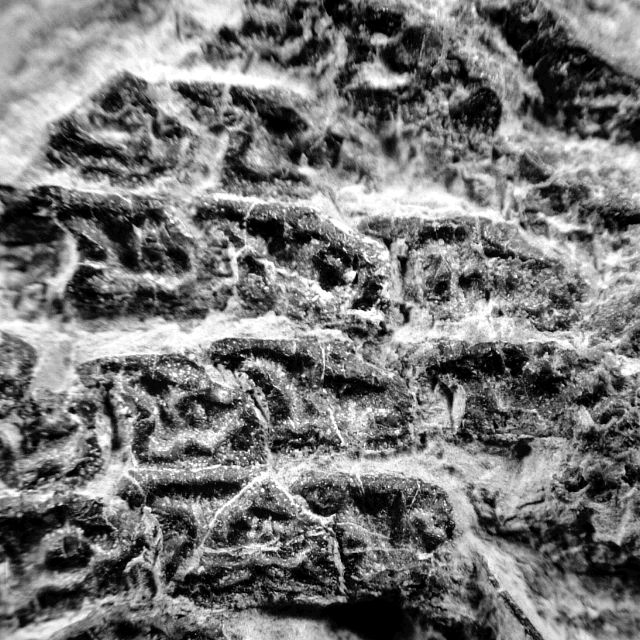Elpistostege
Meet Elpistostege watsoni, the rarest vertebrate species in the Escuminac Formation.
 (84 kb) With only three specimens found during 125 years of searching, Elpistostege symbolizes what exciting discoveries may still be in store for us at Miguasha.
(84 kb) With only three specimens found during 125 years of searching, Elpistostege symbolizes what exciting discoveries may still be in store for us at Miguasha.
The three known specimens of this animal are: part of the top of a skull, preserved at the British Museum of Natural History in London; an incomplete skull displaying the snout in the Miguasha National Park collection; and a partial section of the trunk, also in the Miguasha collection. Absolutely nothing is known about its fins.

 (116 kb)Because the Elpistostege fossil record is so incomplete, paleontologists have had to refer to another, better known elpistostegalian, Panderichthys, which was discovered in Latvia. Like its Latvian cousin, Elpistostege would have had a flattened skull with prominent eyes along the top, bordered above by two strips of bony flange giving the appearance of arched eyebrows. Its scales and ribs were also very pronounced.
(116 kb)Because the Elpistostege fossil record is so incomplete, paleontologists have had to refer to another, better known elpistostegalian, Panderichthys, which was discovered in Latvia. Like its Latvian cousin, Elpistostege would have had a flattened skull with prominent eyes along the top, bordered above by two strips of bony flange giving the appearance of arched eyebrows. Its scales and ribs were also very pronounced.
Panderichthys had rayed fins, and the fins of another, in contrast to the fins of another elpistostegalian from Arctic Canada, Tiktaalik, which displays what looks like the beginnings of digits despite being fringed with rays. What about Elpistostege? The initial study of its skull revealed that it was a little more closely related to tetrapods than Panderichthys. Thomas Stanley Westoll, the paleontologist who named Elpistostege in 1938 based on a partial skull roof, classed it among the stegocephalian amphibians with Acanthostega and Ichthyostega from Greenland. This hypothesis dominated until 1980 when a more complete skull was discovered among the fossils of a private collector in Miguasha.
To what point do the limbs of Elpistostege reflect its relatedness to tetrapods? It is the dream of many scientists visiting Miguasha to one day find the fossilized remains of the missing fins and solve that long-lasting mystery.
The name Elpistostege, from which the group’s name is derived, means “hope from a skull roof”, in reference to the possible tetrapod link. Miguasha has not yet revealed all its secrets, so Elpistostege still suits its name as we hope for the discovery of another specimen that will finally show us to what point this fish was no longer really a fish...

 (84 kb) With only three specimens found during 125 years of searching, Elpistostege symbolizes what exciting discoveries may still be in store for us at Miguasha.
(84 kb) With only three specimens found during 125 years of searching, Elpistostege symbolizes what exciting discoveries may still be in store for us at Miguasha.The three known specimens of this animal are: part of the top of a skull, preserved at the British Museum of Natural History in London; an incomplete skull displaying the snout in the Miguasha National Park collection; and a partial section of the trunk, also in the Miguasha collection. Absolutely nothing is known about its fins.

 (116 kb)Because the Elpistostege fossil record is so incomplete, paleontologists have had to refer to another, better known elpistostegalian, Panderichthys, which was discovered in Latvia. Like its Latvian cousin, Elpistostege would have had a flattened skull with prominent eyes along the top, bordered above by two strips of bony flange giving the appearance of arched eyebrows. Its scales and ribs were also very pronounced.
(116 kb)Because the Elpistostege fossil record is so incomplete, paleontologists have had to refer to another, better known elpistostegalian, Panderichthys, which was discovered in Latvia. Like its Latvian cousin, Elpistostege would have had a flattened skull with prominent eyes along the top, bordered above by two strips of bony flange giving the appearance of arched eyebrows. Its scales and ribs were also very pronounced.Panderichthys had rayed fins, and the fins of another, in contrast to the fins of another elpistostegalian from Arctic Canada, Tiktaalik, which displays what looks like the beginnings of digits despite being fringed with rays. What about Elpistostege? The initial study of its skull revealed that it was a little more closely related to tetrapods than Panderichthys. Thomas Stanley Westoll, the paleontologist who named Elpistostege in 1938 based on a partial skull roof, classed it among the stegocephalian amphibians with Acanthostega and Ichthyostega from Greenland. This hypothesis dominated until 1980 when a more complete skull was discovered among the fossils of a private collector in Miguasha.
To what point do the limbs of Elpistostege reflect its relatedness to tetrapods? It is the dream of many scientists visiting Miguasha to one day find the fossilized remains of the missing fins and solve that long-lasting mystery.
The name Elpistostege, from which the group’s name is derived, means “hope from a skull roof”, in reference to the possible tetrapod link. Miguasha has not yet revealed all its secrets, so Elpistostege still suits its name as we hope for the discovery of another specimen that will finally show us to what point this fish was no longer really a fish...




